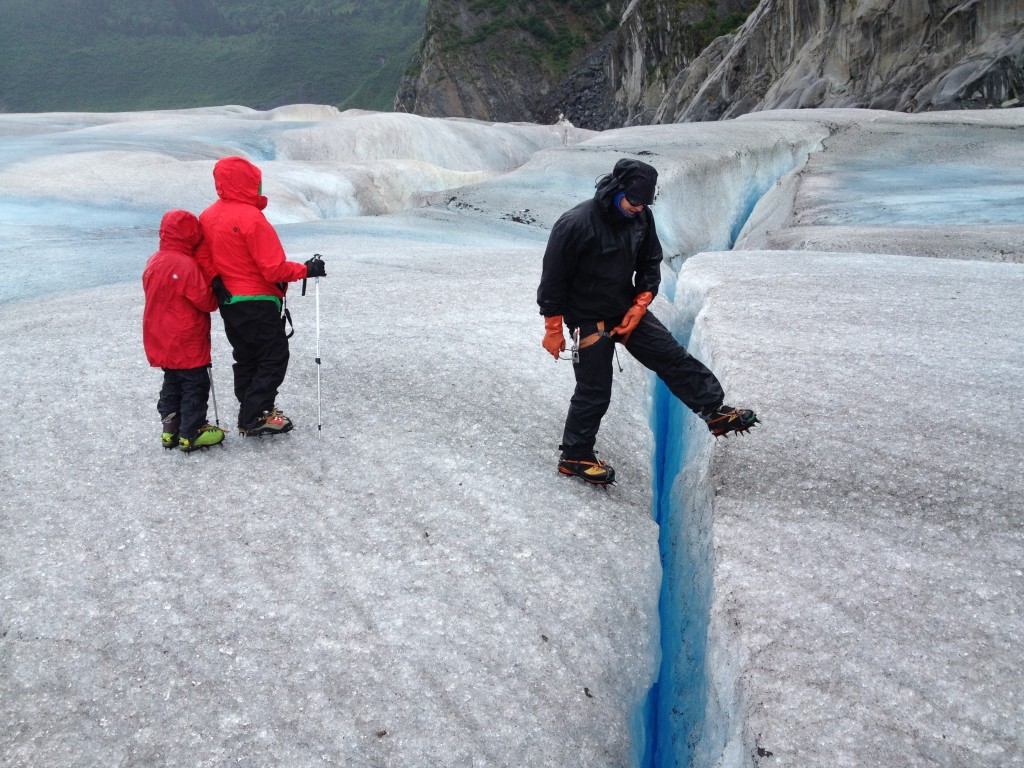By Richard Irwin, Staff Writer
The trio of helicopters maneuvered through the mountain valleys outside Juneau, Alaska. The Astars played tag as they jockeyed through the ice-covered peaks. We soared past several hanging glaciers on our way to Mendenhall Glacier.
The bright, blue helicopters ahead of us disappeared as they dropped into yet another valley or slipped around a corner of the towering mountains. Climbing slightly, we approached our target, a sheet of ice 1,000 feet deep.
The copters took turns hovering over the giant glacier before slowly alighting on the ice. Then one by one, the hikers clambered out of their flying machines to walk to the orange dome that served as base camp for NorthStar Trekking.
The Juneau company is the only one that offers one-, two- or three-hour hikes on the famous glacier. They offer a nice range of adventures, from easy hikes to climbing expeditions on the towering faces of the glacier.
The granular surface was surprisingly hard to walk on, even with the special boots that NorthStar had conveniently provided. Everyone slip-slided to the dome tent, trying to get their land legs after our 48-hour voyage from Seattle on Holland America’s Westerdam.
Our three guides called us over one by one to strap crampons on the bottom of our boots. The inch-long teeth would allow us to pierce the icy surface. Of course, we would have to march off, lifting our legs like soldiers on parade. No strolling here.
And we had to watch for the tiny fissures and holes where our walking poles would suddenly disappear. Little streams of ice cold glacier runoff flowed under our feet. But everyone made it safely to the glacier face.
The huge blocks of ice formed giant stair steps. The climbers above us looked like so many ants crawling on a sugar cube. They gave scale to the grandeur of the Mendenhall Glacier.
Several hikers stopped at a small ice outcropping to fill their water bottles with the pure, clean water flowing down the glacier to the sea. They said the 800-year-old water tasted great.
Peering into the side of the glacier, we were struck by the striking blue color of the ice. It reminded me of the Tidy Bowl tablets people use in their toilets.
But there weren’t any chemicals or dyes in the glacier to make it so blue. Our guide explained how the ice had been compressed by the weight of the snow above it.
“It takes 100 feet of snow to make one foot of glacier ice,” the guide continued. “The ice molecules become so dense that it reflects the shortest light wavelengths, which we see as a bright blue.”
Scientists drill out cores of glacier ice to study global warming. Which is readily apparent to any visitor who sees how far back the mighty glaciers have retreated as they yield to the warming atmosphere.
The first explorers found the glaciers more than 600 feet further out in the valleys. But we weren’t here to debate, we were here to explore.
Off to the side, the glacier was crisscrossed by crevasses. Some were cracks, some were canyons. Many took selfies while straddling the moving sheets of ice. But looking down into the blue fissures, I figured anything you dropped was long gone.
“Some of the crevasses are 800 to 1,000 feet deep,” the guide warned. “So if you drop your cellphone you’ll never see it again.”
Soon, it was time to report back to base camp for our flight out. But the returning helicopters turned their turbines off, the gleaming rotors slowly spooling down.
“Sorry, there’s been a delay. Fog has rolled into the airport and visibility has dropped below 1,000 feet so we can’t return yet,” the pilot explained.
As we stood shivering in the cold, we prayed that the fog would lift enough to get us off Mendenhall Glacier. And a half hour later, it did.

